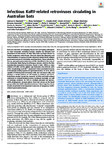2020-04-13Zeitschriftenartikel
Infectious KoRV-related retroviruses circulating in Australian bats
Hayward, Joshua A.
Tachedijan, Mary
Kohl, Claudia
Johnson, Adam
Dearnley, Megan
Jesaveluk, Brianna
Langer, Christine
Solymosi, Philip D.
Hille, Georg
Nitsche, Andreas
Sánchez, Cecilia A.
Werner, Adam
Kontos, Dimitri
Crameri, Gary
Marsh, Glenn A.
Poumbourios, Pantelis
Drummer, Heidi E.
Holmes, Edward C.
Wang, Lin-Fa
Tachedijan, Gilda
Bats are reservoirs of emerging viruses that are highly pathogenic to other mammals, including humans. Despite the diversity and abundance of bat viruses, to date they have not been shown to harbor exogenous retroviruses. Here we report the discovery and characterization of a group of koala retrovirus-related (KoRV-related) gammaretroviruses in Australian and Asian bats. These include the Hervey pteropid gammaretrovirus (HPG), identified in the scat of the Australian black flying fox (Pteropus alecto), which is the first reproduction-competent retrovirus found in bats. HPG is a close relative of KoRV and the gibbon ape leukemia virus (GALV), with virion morphology and Mn2+-dependent virion-associated reverse transcriptase activity typical of a gammaretrovirus. In vitro, HPG is capable of infecting bat and human cells, but not mouse cells, and displays a similar pattern of cell tropism as KoRV-A and GALV. Population studies reveal the presence of HPG and KoRV-related sequences in several locations across northeast Australia, as well as serologic evidence for HPG in multiple pteropid bat species, while phylogenetic analysis places these bat viruses as the basal group within the KoRV-related retroviruses. Taken together, these results reveal bats to be important reservoirs of exogenous KoRV-related gammaretroviruses.
Dateien zu dieser Publikation

